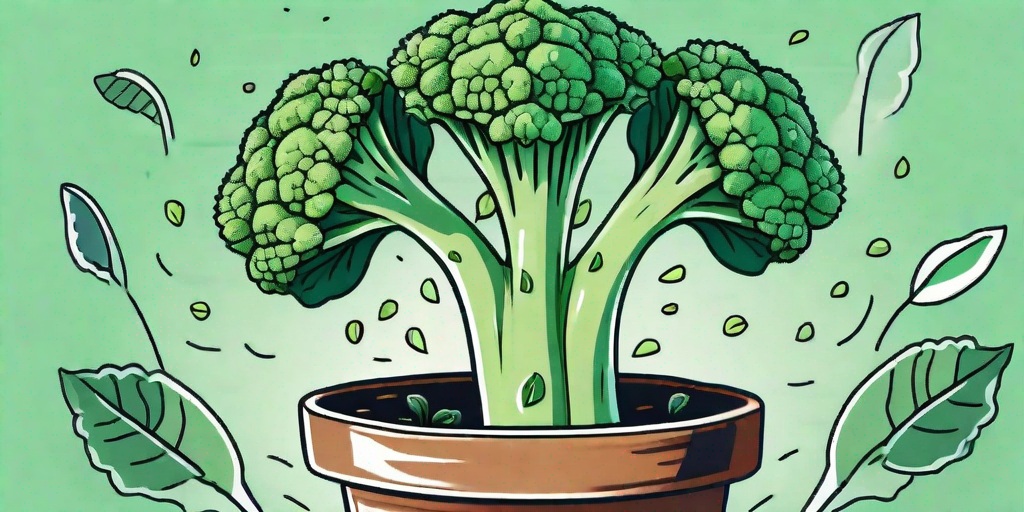
Welcome to the world of horticulture, where the thrill of nurturing a seed into a full-grown plant is a joy unparalleled. Today, we're going to delve into the world of broccoli, that green, tree-like vegetable that you either love or hate. But trust us, once you've grown your own, you'll be a broccoli fan for life! So, let's embark on this journey of transforming you from a broccoli novice to a broccoli bonanza champion.
Understanding Broccoli: The Green Giant
Before we start planting, it's essential to understand what we're dealing with. Broccoli, or Brassica oleracea, is a member of the cabbage family. It's a cool-season crop, which means it prefers to grow in cooler weather. So, if you're living in a place where the sun blazes like a furnace, you might want to give your broccoli a sun hat (just kidding, but shade does help).
Broccoli is a powerhouse of nutrients. It's packed with vitamins A, C, and K, along with dietary fiber. So, not only will you be growing a garden, but you'll also be growing your health. Now, isn't that a win-win?
Getting Started: The Seed Chronicles
Now that we're acquainted with our green friend, let's get down to business. The first step in our broccoli bonanza is getting the right seeds. You can either buy them from a garden center or an online store. Just make sure you're getting a variety that's suitable for your climate.
Once you have your seeds, it's time to plant them. But hold your horses! Before you start digging, you need to prepare the soil. Broccoli prefers well-drained, fertile soil with a pH between 6.0 and 7.0. So, get your soil tested and amend it if necessary. You can add compost or well-rotted manure to improve its fertility.
Planting the Seeds
Plant the seeds about 1/2 inch deep and 3 inches apart. If you're planting in rows, keep the rows about 18 inches apart. This will give your broccoli enough space to grow without feeling claustrophobic. After planting, water the soil well. Remember, broccoli likes to stay hydrated, but not waterlogged.
Now, the waiting game begins. With proper care, your seeds should germinate in about 2 weeks. Once the seedlings are about 2-3 inches tall, thin them out so that they're 12-20 inches apart. This might seem cruel, but it's for the greater good. Trust us, your broccoli will thank you for it.
Nurturing Your Broccoli: The TLC Guide
Planting the seeds is just the beginning. Now, you need to take care of your baby broccoli plants like they're your own. This means watering them regularly, feeding them with a balanced fertilizer, and protecting them from pests and diseases.
Broccoli plants need about 1-1.5 inches of water per week. So, if Mother Nature isn't providing enough rainfall, you'll need to step in. Remember, it's better to water deeply and less frequently than to water a little every day. This encourages the roots to grow deeper into the soil, making the plants more resilient.
Fertilizing Your Broccoli
When it comes to feeding your broccoli, a balanced fertilizer is the way to go. Look for a fertilizer with equal amounts of nitrogen, phosphorus, and potassium. Apply the fertilizer according to the package instructions, usually when the plants are about 4-6 inches tall.
Keep an eye out for pests and diseases. Common broccoli pests include cabbage worms, aphids, and flea beetles. If you notice any of these critters on your plants, don't panic. There are many organic pest control methods you can use, like insecticidal soaps or introducing beneficial insects into your garden.
Harvesting Your Broccoli: The Moment of Truth
After all your hard work, it's finally time to reap the fruits (or in this case, vegetables) of your labor. Broccoli is usually ready to harvest 70-100 days after planting, depending on the variety. The heads should be firm and tight, and the buds should still be closed. If the buds start to open and yellow flowers appear, you've waited too long.
To harvest, simply cut the main head along with 5-6 inches of stem. But don't pull up the plant just yet. If you leave it in the ground, it will produce smaller side shoots that you can harvest later. Now, that's a gift that keeps on giving!
FAQs: The Broccoli Queries
Why is my broccoli turning yellow?
If your broccoli is turning yellow, it's likely that it's overripe. This happens when the broccoli heads are not harvested in time and the buds start to bloom. To prevent this, make sure to harvest your broccoli when the heads are still tight and green.
Can I grow broccoli in a pot?
Absolutely! Broccoli can be grown in pots or containers as long as they're at least 12 inches deep and 20 inches wide. Just make sure the pot has good drainage to prevent waterlogging.
What can I do with the broccoli leaves?
Don't throw away those leaves! Broccoli leaves are edible and packed with nutrients. You can cook them just like you would kale or spinach.
Conclusion: The Broccoli Bonanza
And there you have it, a comprehensive guide to growing your own broccoli from seed. It might seem like a lot of work, but trust us, the satisfaction of harvesting your own homegrown broccoli is worth every bit of effort. So, what are you waiting for? Get your hands dirty and start your broccoli bonanza today!
Remember, every great gardener was once a beginner. So, don't be disheartened if your first attempt doesn't go as planned. Learn from your mistakes, keep trying, and soon you'll be a broccoli-growing pro. Happy gardening!











